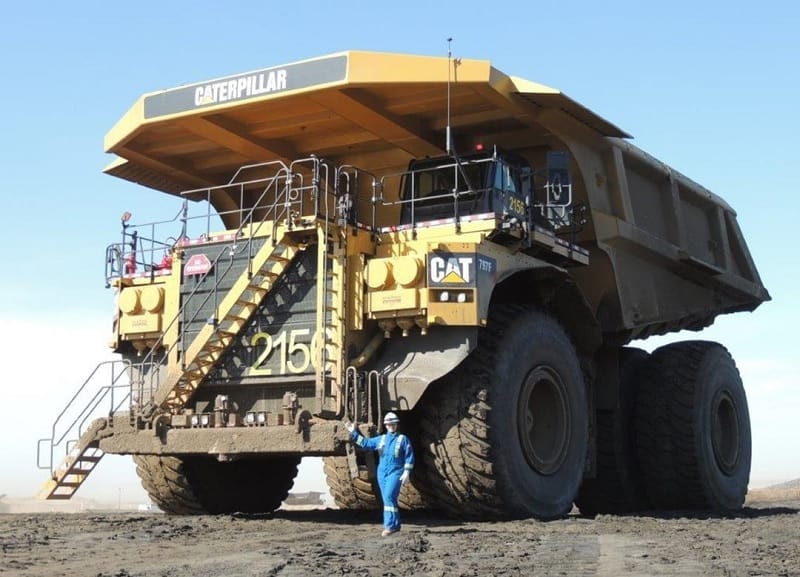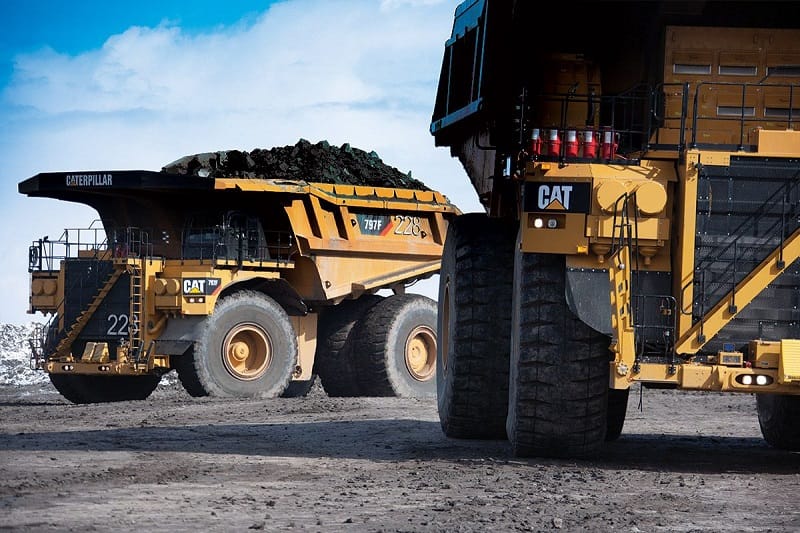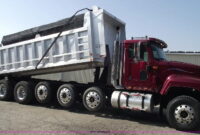Mining Dump Truck Size: A Detailed Overview catdumptruck.com | Mining operations rely heavily on powerful, heavy-duty equipment, and among the most iconic and essential machines in this field is the mining dump truck.
These colossal vehicles are built to haul enormous quantities of materials such as ore, coal, and overburden from one location to another.
One of the most critical aspects of these machines is their size—a factor that directly influences productivity, safety, and operational efficiency.
In this article, we’ll explore the typical sizes of mining dump trucks, how they compare to other types of dump trucks, and what factors affect their design and dimensions.
Read More: Dump Truck Size Chart in Feet: A Complete Guide
Mining Dump Truck Size: A Detailed Overview
1. What is a Mining Dump?
A mining dump truck, also known as an off-highway dump truck or haul truck, is a specialized heavy-duty vehicle used in large-scale mining operations.
These trucks are not designed for road use due to their size and weight. Instead, they operate within open-pit mines and large quarries, transporting massive loads of raw materials over rough terrain.
Unlike standard dump trucks used in construction, mining dump trucks are built to withstand extreme environments, heavy wear, and prolonged use.
2. How Big Are Mining Dump Trucks?
Mining dump trucks are among the largest land vehicles ever built. Their size can vary depending on the model, but here are typical dimensions:
General Size Ranges:
- Length: 10 to 20 meters (32 to 65 feet)
- Width: 6 to 10 meters (20 to 33 feet)
- Height: 5 to 8 meters (16 to 26 feet)
- Tire Height Alone: Up to 4 meters (13 feet)
These dimensions allow mining dump trucks to carry between 100 to over 400 tonnes of material per load. The larger the truck, the more efficient the operation can be—if the site supports such a massive scale.
3. Popular Mining Dump Truck Models and Sizes
Let’s take a look at some of the most well-known mining dump trucks and their specifications.
A. Caterpillar 797F
One of the most recognizable mining trucks globally, the CAT 797F is known for its immense size and payload capacity.
- Length: 15.1 meters
- Width: 9.7 meters
- Height (empty): 6.5 meters
- Payload capacity: 400 short tons (363 metric tonnes)
- Engine: 4,000 HP
The 797F can carry enough material in a single load to fill an Olympic-sized swimming pool.
B. BelAZ 75710
This is currently the largest mining dump truck in the world.
- Length: 20.6 meters
- Width: 9.87 meters
- Height: 8.16 meters
- Payload capacity: 450 metric tonnes
- Engine: Dual diesel-electric engines totaling 4,600 HP
Its 8-wheel design provides better load distribution, making it incredibly efficient despite its size.
C. Komatsu 980E-4
A widely used ultra-class haul truck from Komatsu.
- Length: 15.6 meters
- Width: 9.2 meters
- Height: 7.4 meters
- Payload capacity: 363 tonnes
- Engine: 3,500 HP
It features advanced electronics and an electric drive system for efficient power usage.
D. Liebherr T 284
Liebherr’s flagship mining truck combines massive size with fuel efficiency.
- Length: 15.3 meters
- Width: 9.6 meters
- Height: 7.4 meters
- Payload capacity: 363 tonnes
- Empty weight: 237 tonnes
It is known for its lightweight structure compared to its payload class, increasing fuel savings.
4. Classification of Mining Dump Trucks by Size
Mining dump trucks are typically classified into three categories based on their payload capacity:
a. Mid-Class (100–200 tonnes)
- Examples: Komatsu HD785, CAT 777
- Suitable for medium-size mining or quarry operations
- More maneuverable in tighter areas
b. Heavy-Class (200–300 tonnes)
- Examples: CAT 793, Komatsu 830E
- A balance between mobility and capacity
- Common in both coal and metal mining operations
c. Ultra-Class (300+ tonnes)
- Examples: CAT 797F, BelAZ 75710, Liebherr T 284
- Designed for large open-pit mining operations
- Highest productivity, but also require specialized maintenance and infrastructure
5. Why Size Matters in Mining Dump Trucks
The size of a mining dump truck isn’t just for show—it significantly impacts mining productivity and logistics. Here’s how:
- Higher Payloads = Fewer Trips: Larger trucks move more material in a single run, reducing fuel use and time.
- Fuel Efficiency: Surprisingly, ultra-class trucks may use less fuel per ton of material moved.
- Operational Scale: Larger dump trucks work best in sites with wide haul roads, large loading equipment, and vast spaces.
- Infrastructure Requirements: Bigger trucks need specially designed maintenance bays, fueling stations, and storage areas.
6. Limitations of Bigger Trucks
While bigger sounds better, there are some downsides to ultra-sized dump trucks:
- Cost: Can range from $4 to $6 million per unit.
- Maintenance: Parts are expensive and require heavy-duty handling equipment.
- Maneuverability: Not suitable for small or narrow mining sites.
Road Construction: Haul roads must be wider, stronger, and flatter to accommodate massive machines.
7. Dump Body Volume and Size
Mining dump truck bodies (the beds that hold material) are also massive. Dump bodies are often measured in cubic meters or cubic yards, depending on the region.
- Average body size: 100–200 cubic yards (76–153 cubic meters)
- Custom bodies: Designed for specific material densities like ore or overburden
- Body design matters: A light body with a high volume is used for lighter materials, while dense ore requires stronger, smaller-volume bodies to handle the weight.
8. Tire Size and Load

The tires on mining dump trucks are some of the largest in the world, sometimes costing over $40,000 each.
- Height: Up to 4 meters (13 feet)
- Weight: Up to 5,300 kg (11,700 lbs)
- Load capacity: Over 100 tonnes per tire
Only a few companies manufacture tires of this scale, such as Michelin, Bridgestone, and Goodyear.
9. Future of Mining Dump Trucks
As technology advances, the size of mining dump trucks continues to evolve. Trends include:
- Autonomous trucks: Self-driving dump trucks are becoming more common to improve safety and reduce labor costs.
- Electric power: Hybrid and fully electric trucks are in development to reduce emissions.
- Lighter materials: Composite materials are being tested to make massive trucks lighter and more fuel-efficient.
10. Conclusion
Mining dump truck size plays a critical role in the efficiency and success of mining operations. These massive machines can haul hundreds of tonnes per load and operate in some of the most rugged conditions on Earth.
Their size—whether measured in meters, tonnes, or cubic yards—directly influences site design, production rates, and operational costs.
From the 100-ton mid-sized haulers to the record-breaking BelAZ 75710 with a 450-ton payload, mining dump trucks continue to grow in both size and capability. As mining scales up, so do these engineering marvels, helping shape the modern world—one massive load at a time.
- Dump Truck Size in Meters: A Comprehensive Guide - April 26, 2025
- Dump Truck Size in Yards: A Complete Guide - April 26, 2025
- Mining Dump Truck Size: A Detailed Overview - April 26, 2025





